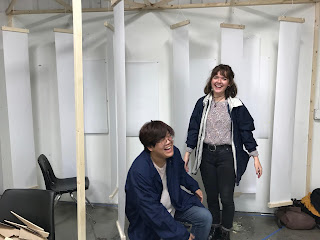Tuesday, November 13, 2018
Finals: Setback
So some of our panels were destroyed because of multiples accidents. Therefore, we were forced make some of the smaller panels over and hang them again.
Finals: Frame Set-up
We started assembling the frame in studio by screwing the frame into the wall. We also started hanging up the panels using nylon ropes.
Final: Wood Shop
We went to the work shop to use the tools to cut the wood and assemble our frame. We used the miter saw to cut the 8 feet 2x2 wood into 20in pieces and 10in pieces. We then placed it through the plainer to create sharp 90 degree angles. We created 8 20 in panels and 16 20in panels. We then split it in half. We then sanded the wood panels to remove any markings and splinters. We assembled the top portion of the frame using a nail gun and screw driver. We also cut braces out of plywood using the band saw to add more structure to the frame.
Final: Panel Macket
We created mackets of the panels to experience with the shadows and lighting. We also wanted to test how big the panels should be.
Saturday, November 3, 2018
Final: Prototype 2
For the second prototype we wanted to keep the same feeling of floating in time, however we also wanted to experiment with different frameworks. We settled on a triangle since it can be very flexible on where it is placed. We could either place it in a corner or against a wall with the point sticking out to create more dynamic. We then experimented with the density of the piece again and settled on making only 2 sizes of the panels rather than multiple.
Final: Prototype 1
Our first prototype wanted to focus around the feeling of frozen in time. We accomplished it by creating panels with patterns inspired by nature and different time period architectures to help the viewers linger in this space. For the frame we experimented with a hexagonal shape using balsa wood. We also wanted to play with the density of the piece, therefore we created bigger panels on the outside and as it got toward the center the panels become more dense and smaller. We plan to put light sources surrounding the piece to play with the shadow ad reflections of that the patterns on the panels create.
Sunday, October 28, 2018
Yayoi Kusama's Immersive Artworks
Yayoi Kusama is a Japanese artist crowned as "Princess of Polka Dots". Shes a artist who's widely known for her immersive project " The Looking Glass". Where Kusama plays with the concept of infinity. She creates this feeling by constructing multiple mirror rooms with different concepts and theme within each of them.
"All the Eternal Love I Have for the Pumpkins"
"Aftermath of Obliteration of Infinity"
"The Obliteration Room"
Finals : Einstein's Dreams
This first concept is four boxes that are only connect on the edges of one side with holes in the back of each boxes facing each other. The purpose of this is to allow the views to reach their arm into the hole and stretch towards the other participants that are in the boxes. The goal is for them to struggle reaching one another and rarely actually touching, creating a stuck in time feeling.
This concept plays with the silhouettes of the participants. Multiple large pieces of paper dangled from the ceiling and in a row are with spaces in between large enough to fit a person. A light source will then be at one end shining through the pieces and as the participants walk between the pieces of paper they are able to see other's silhouettes but never meet.
Similar to the previous concept, this concept also plays with the silhouette of the participants. However this one will be set up as a maze with multiple light sources all around them. The participants are then able to move through the maze freely and see the silhouettes of the others around them, but not knowing where they are to reach them. The maze also adds to the feeling of being stuck.
This next concept reflects the 3 separate accounts of holiness in time within Einstein's dream. Each boxes will be surrounded by flowers leading the viewers to want and step into the boxes. However the box' entrances will be low requiring the viewers to crawl into it and also preventing the views from seeing what's inside. Inside the boxes will be plain recreating the feeling of loneliness. The viewers are now also trapped and would have to find a way to crawl out again.
The last concept plays with the concept of time having different textures. There will be multiple boxes with each having a different texture such as using strings and glue to mimic stickiness or fabric to mimic the soft and flow of time.
Saturday, October 13, 2018
Emperor Robe : Progress
For this project I decided to recreate an emperor's robe. I took many influences from countries such as Japan, China, and Vietnam for my designs. The robe is made of raw silk which is often associated with Asia. I chose to print the robe in red and gold, a common color found in almost every Asian country. The color red represents luck while the gold represents wealth. I wanted to challenge myself by hand sewing everything from scratch. Although it was very time consuming and hard, I have no regret. The process was very tedious, but looking at the product and being able to say I hand sewed everything myself is the biggest reward. I've learned so much through hand sewing that I wouldn't have been able to if I would've relied on a machine.
Subscribe to:
Comments (Atom)



















































